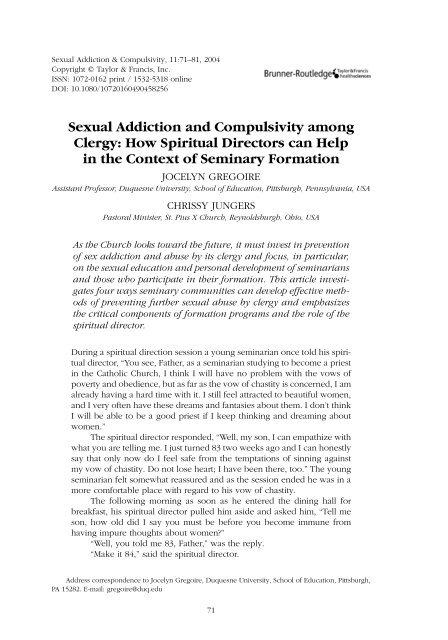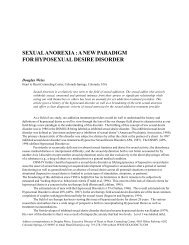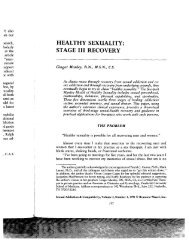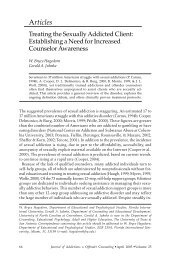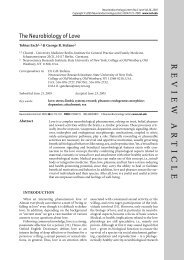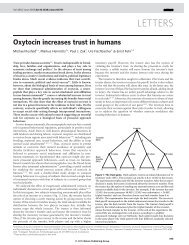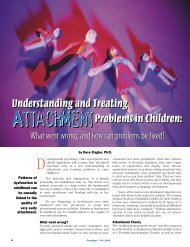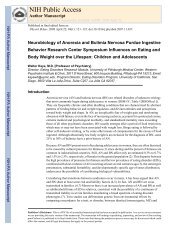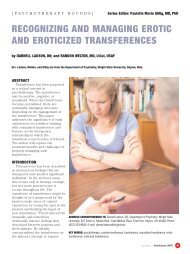Sexual Addiction and Compulsivity among Clergy: How Spiritual ...
Sexual Addiction and Compulsivity among Clergy: How Spiritual ...
Sexual Addiction and Compulsivity among Clergy: How Spiritual ...
Create successful ePaper yourself
Turn your PDF publications into a flip-book with our unique Google optimized e-Paper software.
<strong>Sexual</strong> <strong>Addiction</strong> & <strong>Compulsivity</strong>, 11:71–81, 2004Copyright © Taylor & Francis, Inc.ISSN: 1072-0162 print / 1532-5318 onlineDOI: 10.1080/10720160490458256<strong>Sexual</strong> <strong>Addiction</strong> <strong>and</strong> <strong>Compulsivity</strong> <strong>among</strong><strong>Clergy</strong>: <strong>How</strong> <strong>Spiritual</strong> Directors can Helpin the Context of Seminary FormationJOCELYN GREGOIREAssistant Professor, Duquesne University, School of Education, Pittsburgh, Pennsylvania, USACHRISSY JUNGERSPastoral Minister, St. Pius X Church, Reynoldsburgh, Ohio, USAAs the Church looks toward the future, it must invest in preventionof sex addiction <strong>and</strong> abuse by its clergy <strong>and</strong> focus, in particular,on the sexual education <strong>and</strong> personal development of seminarians<strong>and</strong> those who participate in their formation. This article investigatesfour ways seminary communities can develop effective methodsof preventing further sexual abuse by clergy <strong>and</strong> emphasizesthe critical components of formation programs <strong>and</strong> the role of thespiritual director.During a spiritual direction session a young seminarian once told his spiritualdirector, “You see, Father, as a seminarian studying to become a priestin the Catholic Church, I think I will have no problem with the vows ofpoverty <strong>and</strong> obedience, but as far as the vow of chastity is concerned, I amalready having a hard time with it. I still feel attracted to beautiful women,<strong>and</strong> I very often have these dreams <strong>and</strong> fantasies about them. I don’t thinkI will be able to be a good priest if I keep thinking <strong>and</strong> dreaming aboutwomen.”The spiritual director responded, “Well, my son, I can empathize withwhat you are telling me. I just turned 83 two weeks ago <strong>and</strong> I can honestlysay that only now do I feel safe from the temptations of sinning againstmy vow of chastity. Do not lose heart; I have been there, too.” The youngseminarian felt somewhat reassured <strong>and</strong> as the session ended he was in amore comfortable place with regard to his vow of chastity.The following morning as soon as he entered the dining hall forbreakfast, his spiritual director pulled him aside <strong>and</strong> asked him, “Tell meson, how old did I say you must be before you become immune fromhaving impure thoughts about women?”“Well, you told me 83, Father,” was the reply.“Make it 84,” said the spiritual director.Address correspondence to Jocelyn Gregoire, Duquesne University, School of Education, Pittsburgh,PA 15282. E-mail: gregoire@duq.edu71
<strong>Sexual</strong> <strong>Addiction</strong> <strong>and</strong> <strong>Compulsivity</strong> <strong>among</strong> <strong>Clergy</strong> 73own how to live the life-time commitment of celibacy or were guided inways of avoiding <strong>and</strong> denying the temptation to act on their sexual drives.Not having had adequate spiritual direction addressing sexuality or academiccourses on human sexuality, some priests may never have had the opportunityto explore their own sexuality <strong>and</strong> may not have learned in the seminaryhow to accept themselves as sexual beings or deal with sexual urges openly<strong>and</strong> appropriately (Gregoire & Jungers, 2003).Two incidents drove the church to reevaluate its seminary formationprograms in the early 1990s. First, the case of serial pedophile Fr. Porter ofthe diocese of Fall River, Massachusetts drew attention to sexual abuse inthe church not only <strong>among</strong> the general public, but also <strong>among</strong> the fraternityof priests. Second, in 1992, Pope John Paul II issued a statement in PastoresDabo Vobis that the formation of priests must be reorganized to focus on fourareas—human, intellectual, pastoral, <strong>and</strong> spiritual—<strong>and</strong> include a more opendialogue of sexuality <strong>and</strong> celibacy (Investigative Staff of The Boston Globe,2002).In response to these events, seminary rectors <strong>and</strong> church hierarchy implementeda system for detecting the presence of psychological illness inc<strong>and</strong>idates desiring to study for the priesthood. Before they are admitted tothe seminary, men are now required to undergo extensive screening. All c<strong>and</strong>idatesmust participate in a series of written <strong>and</strong> projective psychologicaltests such as the Minnesota Multiphasic Personality Inventory–2 (MMPI–2)<strong>and</strong> Rorschach <strong>and</strong> submit to two interviews with a psychologist (MMPI–2,1989; Exner, 2001). Bishops <strong>and</strong> seminary rectors may only accept c<strong>and</strong>idateswho, through testing <strong>and</strong> interview results, appear to be psychologically<strong>and</strong> psychosexually healthy. Furthermore, during the course of theirformation, seminarians are evaluated twice a year to ensure they are meetingthe requirements for proper human, pastoral, academic, <strong>and</strong> spiritual development(Coleman, 2001). Johansen (2003) reports that some seminaries alsohave considered using the <strong>Sexual</strong> History Survey developed by Rev. StephenRossetti as a tool for identifying problematic sexual behaviors in c<strong>and</strong>idates,though none have officially adopted the survey as part of their admittanceprocess.GRASSROOTS EDUCATION: TRANSFORMINGFORMATION PROGRAMSScreening c<strong>and</strong>idates is part of a prevention plan whose goal is to ensure thatfuture priests are of sound mental <strong>and</strong> sexual health. <strong>How</strong>ever, as Blanchard<strong>and</strong> Tabachnick (2002) described, another key component of prevention isgrassroots education, which entails using professionals in the area of sexaddiction to facilitate dialogue on the issue of sexual health. It is especiallyin this area that much potential exists for creating highly effective
74 J. Gregoire <strong>and</strong> C. Jungerseducational programs on sexuality, intimacy, celibacy, <strong>and</strong> peripheral issuessuch as setting boundaries, appropriate behaviors, <strong>and</strong> legal <strong>and</strong> ethical issuessurrounding sexual misbehavior. Education is beneficial for both seminarians<strong>and</strong> spiritual directors who participate in seminarians’ spiritual <strong>and</strong>personal formation.Grounds for More Education for SeminariansPriests themselves have indicated the need for further education on humansexuality in a survey distributed by The Kansas Star to all dioceses in theUnited States except one. The Star received 801 responses from the 3,013surveys it issued. In a question asking what the Church can do to deal withpriests’ needs <strong>and</strong> concerns regarding HIV <strong>and</strong> AIDS in the clergy, about 93%of respondents believed that providing more education in the seminaries onsexual issues would be an effective response to this issue (Thomas, 1999).While this article is not concerned with the issues of HIV <strong>and</strong> AIDS in theclergy, this statistic is telling because it indicates that clergy believe there isa lack of education around sexual issues in the seminary.Additional support for increased education comes from Francis <strong>and</strong>Turner (1995), who examined the characteristics of perpetrators of sexualmisconduct in the church <strong>and</strong> described a group of clergy who “victimizethrough a lack of insight into boundary issues <strong>and</strong> power abuse” (p. 220). Unableto see the difference between normal behaviors <strong>and</strong> misconduct, theseclergy may schedule meetings with parishioners at odd hours such as late atnight, hug or touch parishioners in ways that can be interpreted as sexual,<strong>and</strong> in general work to reduce any power differential between themselves<strong>and</strong> their congregation. The authors suggested that these perpetrators arefundamentally healthy individuals (<strong>and</strong> thus may not have raised any concernsto bishops or rectors during their screening process) who “can oftenbe helped by appropriate education, supervision, <strong>and</strong> short-term counseling”(Francis & Turner, 1995, p. 220).Seminaries do appear to be making some provisions for more open dialogueabout sexuality. Students are required to take a course on humansexuality, as well as attend workshops on sexuality, celibacy, <strong>and</strong> sexualabuse (Coleman, 2001). When such workshops, courses, or conferences arebeing designed, seminaries must offer information from more than a theological<strong>and</strong> moral perspective. Presentations on the theology of the body orsexual ethics courses can inform the intellect of seminarians on church orthodoxy,but they probably will not address the need for dialogue about thelived-experience of celibacy or promote discussion or individual reflection byseminarians about their sexual histories <strong>and</strong> current levels of comfort withtheir sexuality. Professionals who are knowledgeable in the areas of sexabuse, sex addiction treatment, <strong>and</strong> healthy sexuality would be extremelyhelpful in providing seminarians with this type of dialogue.
<strong>Sexual</strong> <strong>Addiction</strong> <strong>and</strong> <strong>Compulsivity</strong> <strong>among</strong> <strong>Clergy</strong> 75As seminaries continue to develop educational programs around sexuality,they would do well to compose a set of objectives for students whocomplete the trainings. In the <strong>Clergy</strong> <strong>Sexual</strong>ity Survey (CSS) (Delmonico,Laaser, & Gufstason, 2004), clergy were asked to evaluate the training theyhad in a variety of areas related to issues of sexuality. Using the areas outlinedin the CSS, rectors might ask whether seminarians: Learned to maintain professional boundaries with parishioners, colleagues,<strong>and</strong> staff Learned ethical <strong>and</strong> professional issues associated with sex with parishioners,colleagues, staff Learned how to h<strong>and</strong>le difficult sexual situations Learned about general sexuality Learned about general sexual boundary issues Learned what to do when in a sexually compromising situation Learned how to discuss sexuality with parishioners Learned healthy sexual boundaries with children Learned what to do if in “sexual trouble”Education for <strong>Spiritual</strong> DirectorsAlerting future priests to the differences between healthy <strong>and</strong> unhealthy sexualityis one element of a formation program aimed at preventing sexualaddictions from developing in secret in seminaries. A second componentdeals with alerting spiritual directors about these same issues. Education canraise seminarians’ level of awareness about a variety of sexual issues. <strong>How</strong>ever,becoming educated does not guarantee that seminarians will feel free todiscuss concerns about personal sexual issues with their superiors or formationdirectors. Talking about sexual issues is difficult for lay people <strong>and</strong> maybe even more so for future priests, who, “it seems . . . by virtue of their rolein society are not to have any sexuality” (Francis & Turner, 1995, p. 219).The only individual many seminarians will feel comfortable approachingwith questions or worries about their sexual health is their spiritual director(Rafferty, 2002). This places spiritual directors in a critical position for providingintervention for seminarians who exhibit signs of sexual addictions.Thus, reframing the classical role of the spiritual director in seminaries maybe key in helping the church avoid future incidences of sexual misconduct,addictions, <strong>and</strong> ultimately sc<strong>and</strong>als.What is <strong>Spiritual</strong> Direction?In the Christian tradition, spiritual direction is a unique relationship betweentwo individuals in which one individual seeks out the other for guidance in
76 J. Gregoire <strong>and</strong> C. Jungersdeveloping an intimate union with God. The special attention paid to theperson’s relationship with God distinguishes spiritual direction from otherexperiences such as counseling, moral guidance, confession, preaching, orgeneral pastoral ministry. Typically, spiritual direction is concerned with aperson’s interior life more than his or her exterior life <strong>and</strong> is always mindfulthat the Spirit of God is part of the discourse in which the director <strong>and</strong>directee engage (Barry & Connolly, 1982; Nemeck & Coombs, 1985).Without detracting from the traditional role spiritual directors take inhelping seminarians deepen their relationship with God, it would be prudentfor them to be well-informed about the signs of problematic sexual behaviors,sexual anorexia, <strong>and</strong> cyber-sex addictions. Because of the confidential natureof the spiritual direction relationship, seminarians who suspect that they havea sexual addiction might use this relationship as the one place where theybegin to share their questions about their sexuality. Only when spiritualdirectors are educated about the signs of sexual addictions can they respondappropriately <strong>and</strong> promptly to their directees in this area.Raising awareness about their own sexuality <strong>and</strong> personal issues aroundsex <strong>and</strong> sexuality is another reason education is important for spiritual directors.In modern times, the practice of spiritual direction is not the domain ofpriests alone. It has become a profession open to lay men <strong>and</strong> women whocomplete special training programs for spiritual direction. <strong>How</strong>ever, in theseminary environment, spiritual directors are most commonly priests whomay or may not have had formal training in spiritual direction, but whononetheless are recognized to be holy <strong>and</strong> devout individuals capable ofproviding spiritual guidance. It is not improbable that the clergy who directseminarians may be uncomfortable discussing sexual issues with directeesbecause of gaps in their own formation around sexuality. In order to effectivelyapproach the topic of sexuality with directees, spiritual directors needto be comfortable with their own sexuality <strong>and</strong> desensitized enough to raisequestions <strong>and</strong> challenge directees about their sexuality.Identifying Problematic <strong>Sexual</strong> Behaviors, <strong>Addiction</strong>s,<strong>and</strong> <strong>Sexual</strong> AnorexiaTeaching spiritual directors about sexual addictions <strong>and</strong> compulsivity shouldinclude key areas: signs of sexual deviance, problematic sexual behaviors,cybersex addiction, <strong>and</strong> sexual anorexia. First, a discussion of some red flagsfor sexual deviance.<strong>Sexual</strong> Deviance or MisconductAlthough there is no foolproof way of identifying persons who will becomechild molesters, Rossetti (1996) suggested six characteristics that can be indicatorsfor pedophilic adults. These characteristics include: (1) Confusion
<strong>Sexual</strong> <strong>Addiction</strong> <strong>and</strong> <strong>Compulsivity</strong> <strong>among</strong> <strong>Clergy</strong> 77about sexual orientation, (2) Childish interests or behavior, (3) Lack of peerrelationships, (4) Extremes in developmental sexual experiences, (5) Personalhistory of childhood sexual abuse <strong>and</strong>/or deviant sexual experiences,<strong>and</strong> (6) An excessively passive, dependent, conforming, personality. In caseswhere enough red flags are present <strong>and</strong> sexual orientation toward minorsseems likely, spiritual directors should refer their directees for professionalevaluation.Problematic <strong>Sexual</strong> BehaviorsTraining spiritual directors to recognize signs of unhealthy sexuality wouldinclude education on the following categories of compulsive sexual behaviors(Carnes, 1991): Fantasy Sex: characterized by thinking or obsessing for large periods oftime about sexual ventures or past, present, or future sexual acts. Seductive Role Sex: identified by many sexual relationships coinciding witheach other or one after the other. People engaging in seductive role sexuse seduction to gain power over others <strong>and</strong> feel good about themselves. Anonymous Sex: involves thoughts, fantasies or encounters with unknownindividuals as well as the pursuit of anonymous individuals in publicdomains. Paying for Sex: involves paying for sexual activity such as a prostitute orescort, phone conversation or Internet sexual activity. Trading Sex: identified by engaging in sexual behaviors for some type ofpayment such as money or drugs Voyeuristic Sex: involves looking at others for sexual gratification, includingpornography Exhibitionism: includes full or partial exposure in public areas, dressingor undressing in public areas <strong>and</strong> wearing revealing clothing Intrusive Sex: characterized by inappropriate intimate touching of others,telling sexually explicit stories or jokes or using a position of power (e.g.,in the workplace) to coerce others into sexual activity. Pain Exchange: described by causing physical harm or emotional humiliationto a person during sexual activity in order to gain pleasure Object Sex: involves the use of objects for masturbation Exploitive Sex: characterized by exposing children to inappropriate sexualmaterial, to adult sexual behaviors, or forcing sexual activity on an adultor child.All of these addictive sexual behaviors also can manifest in Internet use orcybersex addiction. The recommendation for spiritual directors who suspectthe presence of problematic sexual behaviors in their directees is the sameas if they suspect a sexual deviance. Any seminarian who reveals that he
78 J. Gregoire <strong>and</strong> C. Jungersengages in these sex acts should be referred for professional evaluation <strong>and</strong>counseling.Cybersex <strong>Addiction</strong>Educating spiritual directors about the emerging disorder of cybersex addictionis particularly relevant with the popularity of Internet use today. Onegroup highly susceptible to Internet addiction is college students who haveunlimited access to being online <strong>and</strong> who are often required to do researchonline, correspond with professors, <strong>and</strong> register online (Rafferty, 2002). Thissusceptibility applies to seminarians as well because many of them are completingdegrees in theology or philosophy during their formation years <strong>and</strong>have a pattern of Internet use very similar to the average college student.<strong>Spiritual</strong> directors should be concerned about seminarians who become withdrawn,increasingly tired, unable to fulfill obligations, or fail to meet academicst<strong>and</strong>ards after having academic success.In order to do a more in depth analysis of a young man’s Internet use,spiritual directors might rely on Kimberly Young’s (1999) criteria for evaluatingan Internet addiction. An affirmative response to five of the eight criteriawould normally indicate an addiction. These criteria include: preoccupationwith the Internet; increasing amounts of time spent on the Internet to feelsatisfied; recurring attempts <strong>and</strong> failures to control or decrease Internet use;negative emotional response (such as depression) to attempts to cut back use;staying online longer than planned; jeopardizing work or education opportunitiesbecause of Internet use; <strong>and</strong> using the Internet as a form of escape.<strong>Sexual</strong> AnorexiaOne facet of unhealthy sexuality that might be easily overlooked in the seminaryis sexual anorexia, defined by Carnes <strong>and</strong> Moriarity (1997) as “an obsessivestate in which the physical, mental, <strong>and</strong> emotional task of avoiding sexdominates one’s life” (p. 1). In an environment that dem<strong>and</strong>s celibacy <strong>and</strong>has long looked scornfully at sex, it would not be surprising to see characteristicsof sexual anorexia in seminarians. Among other things, sexual anorexicstypically avoid anything sexual, have judgmental attitudes about their own<strong>and</strong> others’ sexuality, feel ashamed about sexual experiences, evade intimacybecause of sexual fears, <strong>and</strong> manage painful life issues by maintainingan aversion to sex (Carnes & Moriarity, 1997). <strong>Spiritual</strong> directors must helptheir directees to clearly delineate the differences between celibacy <strong>and</strong> sexualanorexia. The former is a freely made, well-informed lifestyle choice thatdoes not promote the characteristics of sexual anorexia as ways to “manage”a life of celibacy. The latter, lying at the opposite side of the spectrum fromsexual addiction, is an illness in which individuals have a pathological fearof their own sexuality <strong>and</strong> vacillate between compulsively depriving themselvesof sexual behavior <strong>and</strong> “bingeing” on sexual activity. <strong>Spiritual</strong> directors
<strong>Sexual</strong> <strong>Addiction</strong> <strong>and</strong> <strong>Compulsivity</strong> <strong>among</strong> <strong>Clergy</strong> 79can teach seminarians that sexuality is a fundamental part of humanity evenfor those who are celibate. Being alert to indications that the seminarian isdeveloping a fear of his own sexuality will enable the spiritual director toopen discussions about sexuality <strong>and</strong> challenge the student to refocus onhow celibates can live a life of healthy sexuality without mimicking sexualanorexics’ beliefs <strong>and</strong> behavior patterns.CONSUMER INVOLVEMENT: HOW SEX ADDICTS OR ABUSESURVIVORS CAN CONTRIBUTE TO SEMINARY FORMATIONBlanchard <strong>and</strong> Tabachnick (2002) recommend that prevention programs invitepeople who have been through treatment for sexual abuse or addictionto share their stories with the public. Including a “witness” talk as part ofsexuality training can be an effective way for seminarians to make a connectionto real persons who have struggled either with surviving abuse orovercoming a sexual addiction. Speakers need not be priest offenders or victimsof abuse by a member of the clergy for their testimony to be impactful.Such talks can alert seminarians to victim awareness as well as help themrecognize signs of a developing sex addiction.ORGANIZATIONAL RESPONSEThe final component recommended by Blanchard <strong>and</strong> Tabachnick (2002) fordeveloping an effective prevention plan involves networking with the variousresources that can offer input about sexual addiction <strong>and</strong> abuse. In theseminary community, this component is again a call to provide well-balancededucation on human sexuality <strong>and</strong> sexual addictions. A moral <strong>and</strong> theologicalapproach to education is important but does not reveal enough aboutthe origins of unhealthy sexuality. There is a strong call for the seminary toutilize a variety of community resources so that seminarians’ formation doesnot take place in a “vacuum” where the only approach to underst<strong>and</strong>ing unhealthysexuality is a moral one <strong>and</strong> the only response to sexual misconductis confessing sexual sin.CONCLUSIONThere is a difference between being proactive <strong>and</strong> prevention minded <strong>and</strong>presuming the “guilt” of a particular community because of the behaviorsof some members of that community. By embracing a prevention programthat screens all c<strong>and</strong>idates, provides broad-based sexuality, education, trainsspiritual directors in the signs of unhealthy sexuality, <strong>and</strong> utilizes communityresources, seminaries will begin to decrease the chances of clergy perpetratingabuse. A well-developed prevention program does not operate out of the
80 J. Gregoire <strong>and</strong> C. Jungersassumption that clergy are at high risk for sex addictions, but out of the beliefthat society in general—inclusive of men preparing for the priesthood—benefits from open discussions about healthy <strong>and</strong> unhealthy sexuality. Theformation components that will be most accessible to seminarians <strong>and</strong> probablythe most useful will be: (1) the workshops, classes, <strong>and</strong> conferences onsexuality <strong>and</strong> celibacy <strong>and</strong> (2) the spiritual direction relationship in whichthey can raise questions, doubts, <strong>and</strong> concerns about their sexuality or aboutcelibacy.REFERENCESBarry, W. A., & Connolly, W. J. (1982). The practice of spiritual direction. SanFrancisco, CA: Harper San Francisco.Blanchard, G., & Tabachnick, J. (2002). The prevention of sexual abuse: Psychological<strong>and</strong> public health perspectives. <strong>Sexual</strong> <strong>Addiction</strong> & <strong>Compulsivity</strong>: Journal ofTreatment <strong>and</strong> Prevention, 9(1), 1–13.Carnes, P. J. (1991). Don’t call it love: Recovery from sexual addiction. New York:Bantam Books, pp. 42–44.Carnes, P., & Moriarity, J. (1997). <strong>Sexual</strong> anorexia: Overcoming sexual anorexia.Center City, MN: Hazelden.Coleman, G. D. (2001). Priesthood <strong>and</strong> abusive behavior. Retrieved January 22, 2004,from http://www.dsj.org/vc/2001/jan01/coleman.htmDelmonico, D. L., Laaser, M., Gufstason, G. (2002). <strong>Clergy</strong> <strong>Sexual</strong>ity Survey (CSS).Unpublished manuscript, Duquesne University at Pittsburgh.Exner, J. E. et al. (2001). A Rorschach workbook for the comprehensive system.Asheville, NC: Rorschach Workshops.Francis, P. C., & Turner, N. R. (1995). <strong>Sexual</strong> misconduct within the Christian church:Who are the perpetrators <strong>and</strong> those they victimize? Counseling <strong>and</strong> Values,39(3), 218–227.Gregoire, J., & Jungers, C. (2003). Underst<strong>and</strong>ing the culture of celibacy for thetreatment of priests <strong>and</strong> religious. <strong>Sexual</strong> <strong>Addiction</strong> & <strong>Compulsivity</strong>: The Journalof Treatment <strong>and</strong> Prevention, 10(2–3), 167–177.Hathaway, S. R., & McKinley, J. C. (1989). Minnesota Multiphasic PersonalityInventory–2 (MMPI–2). Minneapolis, MN: National Computer Systems, Inc.Investigative Staff of The Boston Globe. (2002). Betrayal: The crisis in the Catholicchurch. New York: Little, Brown, & Company.Johansen, R. (2003). What’s wrong with our seminaries? An insider speaks out.Retrieved January 22, 2004, from http://www.crisismagazine.com/may2003/feature2.htm.Nemeck, F. K., & Coombs, M. T. (1985). The way of spiritual direction. Collegeville,MN: The Liturgical Press.Rafferty, J. A. (2002). Internet addiction <strong>and</strong> seminary formation. Seminary Journal,8(1), 24–33.Rossetti, S. (1996). A tragic grace: The Catholic church <strong>and</strong> child sexual abuse.Collegeville, MN: The Liturgical Press.
<strong>Sexual</strong> <strong>Addiction</strong> <strong>and</strong> <strong>Compulsivity</strong> <strong>among</strong> <strong>Clergy</strong> 81Sipe, A. R. (1995). Sex, priests, <strong>and</strong> power: Anatomy of a crisis. New York: Brunner/Mazel.Thomas, J. L. (1999). AIDS in the priesthood. Kansas City Star. Retrieved January 22,2004, from http://www.kcstar.com/projects/priests/results.htmYoung, K. (1999). Internet addiction: Symptoms, evaluation, <strong>and</strong> treatment. In L.V<strong>and</strong>er-Creek & T. Jackson (Eds.), Innovations in clinical practice: A sourcebook. Sarasota, FL: Professional Resource Press.


